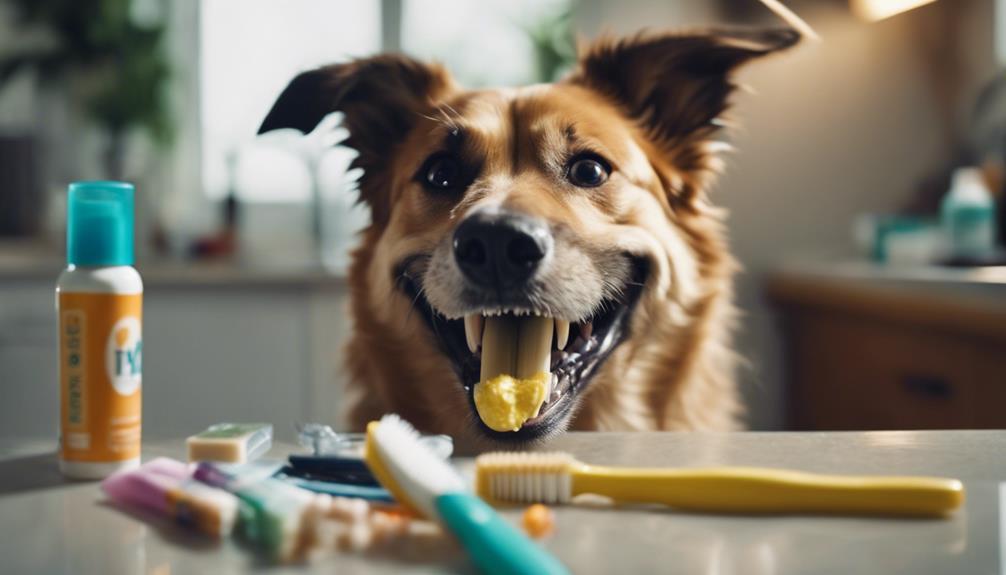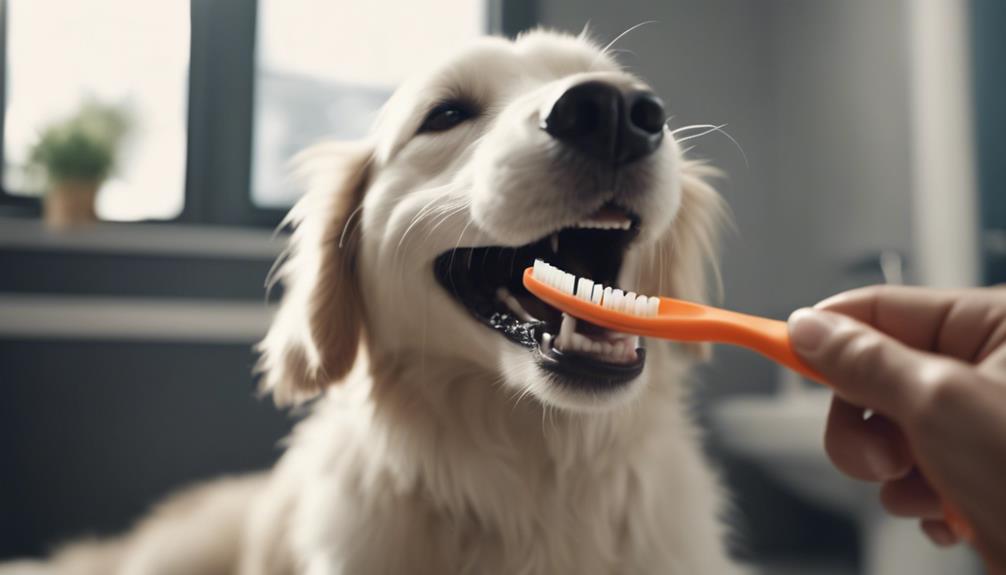In the realm of canine health, the subtleties of tooth decay in dogs can often evade even the most attentive pet owners. The signs may manifest discreetly, hinting at underlying dental issues that can significantly impact a dog's well-being.
Understanding these signs is just the first step towards ensuring your pup's dental health. By exploring the treatment options available for dog rotten teeth and the preventive measures that can be taken, you can embark on a journey to restore your canine companion's smile and vitality.
Key Takeaways
- Dog tooth decay is often unnoticed by owners, requiring detailed dental exams.
- Treatment includes decay removal and fillings, similar to human cavities.
- Prevent decay with daily brushing, dental treats, and professional cleanings.
- Veterinary dentists are crucial for identifying and treating dental issues in dogs.
Understanding Dog Tooth Decay Signs
Destruction of tooth enamel serves as a crucial indicator of tooth decay in dogs. When enamel is compromised, plaque buildup accelerates enamel breakdown, leading to cavity formation.
Owners may not readily detect dental disease symptoms, necessitating thorough oral exams under anesthesia to identify cavities, often located on molar biting surfaces.
Treatment for dog tooth decay mirrors human cavity interventions, involving decay removal with a dental drill and filling using tooth-colored materials. Severe cases may require tooth extraction by a veterinary dentist, highlighting the importance of professional care.
Home removal of rotten teeth is strongly discouraged due to the expertise needed for dental restorations. Understanding these signs and seeking timely intervention can ensure a dog's oral health and overall well-being.
Dog Rotten Teeth Treatment Options
When addressing dog rotten teeth, appropriate treatment options are essential for maintaining the oral health and overall well-being of the canine. Treatment of dog tooth decay mirrors the approach used in human cavity treatment. Removal of decay involves using a dental drill and filling the defect with tooth-colored material.
In severe cases, tooth extraction by a veterinary dentist may be necessary. It is strongly advised against attempting to remove a dog's rotten tooth at home, as dental restorations require specialized training and attention to detail. Seeking professional help ensures proper care and effective treatment, ultimately aiding in restoring the dog's dental health and preventing further complications.
Preventing Future Tooth Decay in Dogs

Implementing a consistent and thorough dental care routine is paramount in preventing future tooth decay in dogs. To ensure your pup's dental health, consider the following key practices:
- Daily Brushing: Regularly brushing your dog's teeth with pet-safe toothpaste helps remove plaque and prevent tartar buildup.
- Tartar-Removing Chew Toys: Providing chew toys designed to promote dental health can aid in reducing tartar and plaque formation.
- Annual Professional Cleanings: Regular visits to the veterinarian for professional cleanings and checkups are essential for early detection and treatment of dental issues.
- Establishing a Routine: Developing a consistent dental care routine from a young age can help prevent gingivitis, periodontal disease, and other oral health problems in dogs.
Importance of Professional Dental Care
Professional dental care plays a pivotal role in ensuring optimal oral health for dogs. Veterinary dentists are crucial in identifying and treating dental issues in dogs, ultimately improving their overall health and well-being. Regular professional cleanings and checkups help prevent dental problems and address any existing issues promptly. Establishing a routine of dental care can significantly enhance a dog's oral hygiene, preventing conditions like gingivitis and periodontal disease. Below is a table highlighting the key benefits of professional dental care for dogs:
| Benefits of Professional Dental Care for Dogs | Description | Impact |
|---|---|---|
| Early Detection of Dental Issues | Identifying problems promptly | Prevents progression of dental diseases |
| Thorough Cleaning and Plaque Removal | Removal of tartar and plaque | Prevents gum disease and tooth decay |
| Treatment of Existing Dental Problems | Addressing cavities and infections | Improves oral health and comfort level |
| Professional Guidance and Recommendations | Tailored advice for dental care | Helps maintain long-term oral health |
Daily Brushing for Dog Dental Health

To maintain optimal oral health for dogs, establishing a routine of daily brushing is essential, serving as a proactive measure in preventing dental issues and promoting overall well-being. Daily brushing helps remove plaque and food debris, reducing the risk of tartar buildup and tooth decay. It also allows for early detection of any abnormalities in your dog's mouth, such as swollen gums or broken teeth, which can then be addressed promptly. Additionally, the mechanical action of brushing stimulates the gums, promoting better circulation and healthier gum tissue. By incorporating daily brushing into your dog's routine, you are taking a significant step towards ensuring their dental health and keeping their smile bright and healthy.
- Removes plaque and food debris effectively.
- Facilitates early detection of oral abnormalities.
- Stimulates gum health through improved circulation.
- Promotes overall dental health and a bright smile for your dog.
Additional Resources on Canine Dental Care
For a comprehensive understanding of canine dental care, exploring additional resources can enhance your knowledge and support your efforts in maintaining your dog's oral health.
Additional articles on preventing tooth decay in dogs emphasize the importance of daily brushing and the use of dental treats. These resources provide detailed insights into maintaining good oral hygiene to prevent gum disease in canines.
They stress the significance of regular dental care in averting gum disease and other dental issues in dogs. By incorporating daily brushing and dental treats into your dog's routine, you can effectively prevent tooth decay and various dental problems.
These additional resources serve as valuable guides in establishing a robust dental care regimen for your canine companion.
Conclusion
In conclusion, the signs of tooth decay in dogs should not be overlooked, as early detection and treatment are crucial for their well-being.
By understanding the treatment options available, prioritizing preventive measures, and seeking professional dental care, we can ensure the dental health of our canine companions.
Implementing daily brushing and providing appropriate chew toys can significantly reduce the risk of future dental issues, ultimately leading to happier and healthier dogs.




